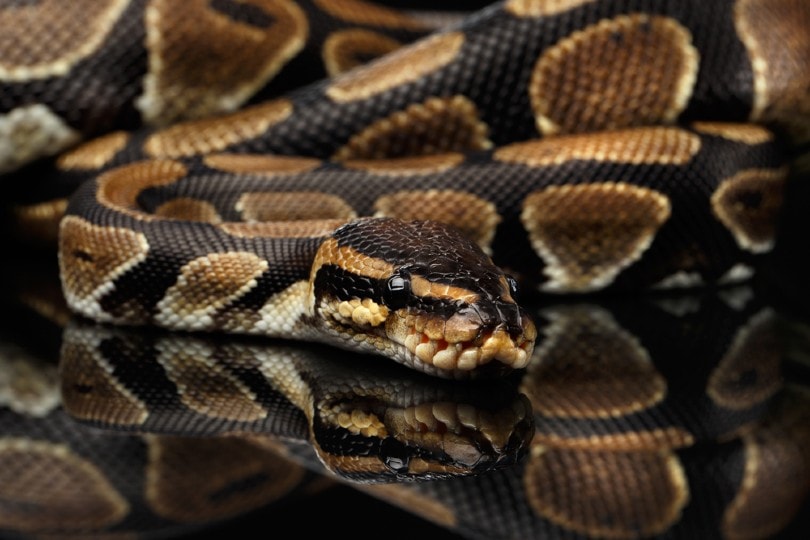How Do You Get a Black Pastel Ball Python

The Black Pastel Ball Python Morph is a different form of the popular reptile. The variation exists with its color that is the result of a co-dominant mutation. Only one copy of this gene is necessary to get this color. This morph is a selectively bred animal that was first domestically produced in 2002 in the United States. Another form you may see is the closely related Cinnamon Ball Python.
It gets its name from the defensive posture it assumes when it feels threatened. It makes excellent use of its coloration while giving it a better position from which to strike.

Quick Facts About Black Pastel Ball Python Morph
| Species Name: | Python regius |
| Common Name: | Black Pastel Ball Python morph |
| Care Level: | Moderate |
| Lifespan: | Up to 30 years or more |
| Adult Size: | Females: 3'–5' L; Males: 2'–3' L |
| Diet: | Small to medium-sized rodents |
| Minimum Tank Size: | 40 gallons for juveniles; at least 4' L for adults |
| Temperature & Humidity: | 78℉–80℉; 50%–60% |
Do Black Pastel Ball Pythons Make Good Pets?
The popularity of the Black Pastel Ball Python lies in its docile nature. That makes it a good pet for a first-time snake owner. Its size is another advantage. Many reptiles grow to large sizes, making housing and feeding them problematic. The other thing you'll face is availability and cost, which we'll discuss later. Otherwise, there are several reasons to keep this species on your shortlist of possible pets.
Appearance
The first thing you'll notice that is different about the Black Pastel Python is its size. It's a much smaller animal compared to other related species, such as the Reticulated Python. That reptile can get up to 20 feet long. It has a dark brown coloration that is punctuated with tan intertwined markings. The top of its head is solid, with a pointed snout and forked tongue. Juveniles are often lighter in color.
This mottled pattern provides excellent camouflage for the python in the wild in the shrublands and savannas of Western Africa. The parent species is classified as one of the least concern, according to the International Union for Conservation of Nature and Natural Resources (IUCN).

How to Take Care of Black Pastel Ball Python
Habitat, Tank Conditions & Setup
The challenge with raising reptiles is replicating the conditions of its environment. That involves maintaining the correct temperature and humidity ranges. Remember that as cold-blooded animals, the internal temperature of reptiles reflects the ambient temp. Drafts and sudden drops are deadly for these animals.
Tank
An aquarium offers the best accommodations for your Black Pastel Ball Python. It is superior for keeping the conditions in their recommended range. A 40-gallon tank is a minimum size for an adult snake. That will give it sufficient room to move around and provide a base for decor elements, such as driftwood and a hiding place.
You should plan on completely cleaning your tank weekly. That will keep the conditions healthy and prevent fungal and bacterial disorders. Unfortunately, the environment that is best suited for pythons also is an ideal one for disease-causing microbes. We recommend using a mild bleach solution on the glass and decor in the empty tank.
Lighting
Your Black Pastel Ball Python will fare best if it gets between 8–12 hours of light a day. That may make it a factor in the placement of your pet's living quarters. You'll find using a timer or smart plug is an efficient way to ensure your snake gets enough light. However, do not leave it on all the time. That creates an unnatural environment that can throw off the reptile's circadian rhythms.
Heating (Temperature & Humidity)
The ideal temperature for a ball python is at least 78℉. You should never let it drop below 75℉. We also recommend adding a basking spot for your pet, where temperatures may get into the 90s or higher. Adding an infrared ceramic light fixture will help ensure that the temperature stays warm enough during the night hours without the distraction of another light.
Make sure to put a thermometer in the tank to monitor the temperature. You'll find combo products that will show the humidity levels, too, to avoid cluttering your aquarium. Adequate moisture is essential for these animals. It will also help your pet during molting.
Substrate
Coconut fiber makes an excellent substrate that is both affordable and natural-looking. You can also recycle it or use it for other plants in your garden. Other options include dampened sphagnum moss or aspen chips, which are equally effective. Make sure to add at least a 3-inch layer to give your snake room to burrow down into the substrate.
| Tank Recommendations | |
| Tank Type: | 40 gallon glass vivarium |
| Lighting: | UV light fixture |
| Heating: | Heating pad/tape on the bottom of the enclosure |
| Best Substrate: | Aspen bedding, coconut fiber, or sphagnum moss |
Feeding Your Black Pastel Ball Python
Like, all snakes, the Black Pastel Ball Python is a carnivore. Depending on its life stage, it'll take birds, rodents, or other prey species. Interestingly, there are sexual differences in their dietary preferences. Females typically take small mammals most often, whereas males prefer avian species. That may, in part, explain the significant sexual dimorphism between the sexes.
We recommend stunning rodents before offering them to your pet. A frightened animal can injure your snake and increase its risk for health problems. You should feed young animals once a week. You can go up to two weeks between meals for adults. If your python is picky, we suggest offering it smaller prey. Always provide fresh water for drinking and bathing.
| Diet Summary | |
| Fruits: | 0% of the diet |
| Insects: | 0% of the diet |
| Meat: | 100% of diet – small/medium-sized rodents |
| Supplements Required: | Not necessary |
Keeping Your Black Pastel Ball Python Healthy
Maintaining the recommended conditions is the single best way to keep your Black Pastel Ball Python healthy. Remember that it evolved in places where the conditions remained relatively stable, down to the amount of daylight. That's your primary task. A thermometer and hydrometer on the tank can provide valuable information to ensure things stay status quo.
Common Health Issues
A healthy python has good-looking skin that is bright and blemish-free. Its eyes are clear, too. The exception is shedding, which we'll discuss shorter.
Red flags that something is amiss include:
- Difficulties when shedding
- Poor appetite
- Skin irritation
- Labored breathing
Common health issues are respiratory diseases, mites, and ticks. The symptoms above will alert you to where to start looking for causes.

Lifespan
A Black Pastel Ball Python can live to the ripe old age of 20 years old if conditions are right. Some long-lived specimens have made it 30 years! Animals in the wild live considerably less because of the myriad of threats they encounter. They are often on the other end of the food chain, where they are hunted for their leather and meat. There is also a legal and illegal pet trade that affects them.
Breeding
Breeding is an involved process that starts with getting healthy adults. Your challenge might begin with finding a suitable mate for your snake. You'll need an incubator for the eggs. Pythons breed seasonally, typically between mid-November to mid-March in the wild. A noticeable temperature drop is essential to trigger mating behavior.
Bear in mind that the two sexes reach maturity at different times, with the males ready by 18 months and the females at 30. The latter can store the eggs within their bodies for months before you know mating has occurred successfully. The female will shed before ovulation before looking for an appropriate place for them.
There are two things worth mentioning. The female may become more aggressive during this time. It's a snake version of the grizzly-bear-mommy mode. Some states prohibit breeding reptiles that can pose a threat to native wildlife. We strongly urge you to contact your state's Department of Natural Resources to find out if it's legal and whether you need a permit.
Is the Black Pastel Ball Python Friendly? Our Handling Advice
Moving slowly and avoiding sudden gestures is the best way to begin handling your pet. Of course, the sooner you begin, the better. Remember the defensive position that ball pythons take if they feel uncomfortable. Respect your snake's space. We suggest avoid handling a breeding female or a molting pet.
Shedding & Brumation: What to Expect
You'll notice changes in your pet's behavior as molting approaches. It may refuse to eat or seem more lethargic. The telltale signs are the clouding over of its eyes. As you may surmise, its ability to see is diminished, making it more agitated about sudden movements and handling. A healthy animal will shed in one complete piece. It's still vulnerable at this time and may be irritable.
How Much Do Black Pastel Ball Python Cost?
Since this morph is domestically produced, the availability can vary. The parent species is a popular one without considering these different forms. You can expect to pay at least $200 or more likely several hundred dollars for a healthy snake. Some specialty breeders with especially desirable juveniles may fetch four figures for their pythons.
Then, there are the costs of setting up your pet's living quarters. We suggest going with the 40-gallon tank to save money by avoiding the cost of an upgrade down the road. Pythons are relatively fast-growing, reaching their adult size in just a few years. You'll also need a lighting and heat source as we described above.
Your ongoing expenses will include substrate and food, which are nominal when compared to the initial costs. There's also the occasional bulb replacement. You can expect to pay between $300–$600 a year to keep your python healthy.
Care Guide Summary
Pros
- Docile nature
- Inquisitive and exploratory
- Simple diet
Cons
- Must be housed individually
- Needs time to adjust to a new environment
- Move a lot during handling

Conclusion
The Black Pastel Ball Python Morph has a lot to offer pet owners new to raising snakes. Their small size and docile nature make them a good beginner reptile. The key to enjoying your experience is to provide the essentials for your python. That will keep it healthy and receptive to handling. Your biggest challenges may be finding one and setting up housing for your new pet.
Featured Image Credit: Seregraff, Shutterstock

Oliver (Ollie) Jones – A zoologist and freelance writer living in South Australia with his partner Alex, their dog Pepper, and their cat Steve (who declined to be pictured). Ollie, originally from the USA, holds his master's degree in wildlife biology and moved to Australia to pursue his career and passion but has found a new love for working online and writing about animals of all types.
Contents
- Quick Facts About Black Pastel Ball Python Morph
- Do Black Pastel Ball Pythons Make Good Pets?
- Appearance
- How to Take Care of Black Pastel Ball Python
- Habitat, Tank Conditions & Setup
- Feeding Your Black Pastel Ball Python
- Keeping Your Black Pastel Ball Python Healthy
- Common Health Issues
- Lifespan
- Breeding
- Is the Black Pastel Ball Python Friendly? Our Handling Advice
- Shedding & Brumation: What to Expect
- How Much Do Black Pastel Ball Python Cost?
- Care Guide Summary
- Conclusion
- Related
How Do You Get a Black Pastel Ball Python
Source: https://petkeen.com/black-pastel-ball-python-morph/